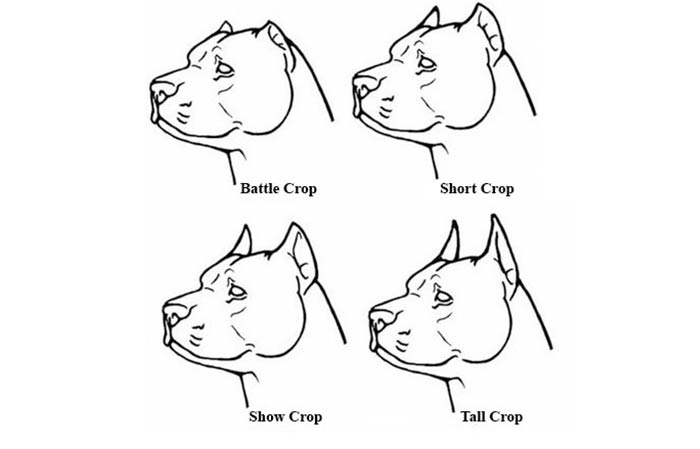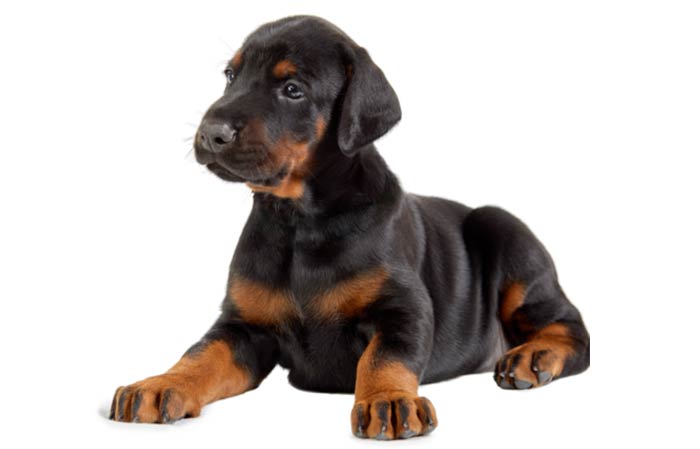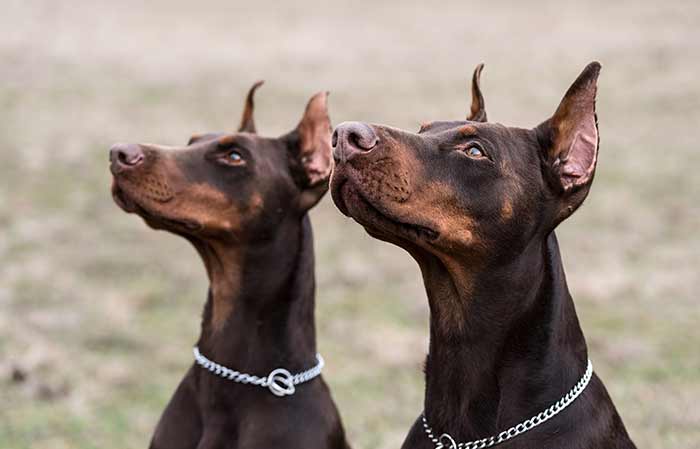Multiple working dogs like the Doberman, cane Corso, and the American pitbull have their ears cropped as early as eight to ten weeks. For decades, the practice has been a way to make them look more erect, sharp, attentive, and dominative as a wolf. However, over the years the practice has now become a cosmetic procedure with the aim of making your dog look better than it would with floppy years.
There are several cropping options available for Doberman pinscher including show style, pet/ military-style, battle, short among others.
As much as the procedure has to done by a licensed and qualified veterinarian, you have to be committed to the dog’s post-op care as it is the most crucial period. Following are details on the crop styles with aftercare tips at home.
Cropping Styles


There are four common cropping styles you can use on your Doberman. They are;
Battle Crop
The shortest crop among the viable options. This low cut is said to offer protection from dirt and insects that could affect the health of the pet. In the ancient days, dog owners cropped the ears of their pets in a quest to prevent and protect the dog from ear infections and hematomas. This cropping style works just the same.
Working Crop
Also known as the pet or military crop, it’s equally short as the battle crop. It’s the most prevalent dropping technique, especially on non-show dogs. The crop features a short sized, wide base, and triangular-shaped ears cut with the aim of changing even the physical appeal of the dog.
The reasons behind this crop majorly lie with security. The Doberman is a guard dog and what most owners believe, cropping the ears will allow the dog to be more alert and attentive. Luckily, this technique only requires a short recovery period after which the pet’s ears can easily stand.
Medium Crop
This crop is a combination of the working crop and the show crop. The cut done to the dog’s ear is not too much and not too little, however, the aftercare needed is much more compared to the former style above.
Show Crop
Time and time again dogs get into show contests where they exhibit their looks and different styles used. The show crop is the longest crop that features a curved silhouette.
This technique will take the dog longer to train than any other style. Moreover, care after surgery is quite long and requires commitment and dedication to ensure the dog heals properly.
Also referred to as the eagle’s wing, there have been various alliterations to the design. More often than not, some owners will comfort to a second surgery to get the perfect shape. Even with the high risks of deformity involved with this style, many owners options for it.

Aftercare
After surgery, the first week is very crucial to the recovery of the puppy. Remember your puppy of eight to 12 weeks will be in anguishing pain once the anesthesia fades.
They will experience distress from the procedure, discomfort, and sometimes they will have a nudge to scratch their ears. This is the most important part of the recovery process; you have to retrain your Doberman from scratching or messing with their ears.
To aid in such a case, your veterinarian will recommend you purchase the E-collar, also called the Elizabethan collar. The collar will cover the upper section of the head, therefore, restraining it from even touching their ears.
Another benefit of the E-collar is to help prevent your puppy from hitting or rubbing the head or ears against rough surfaces – you know how painful that will be.
Aftercare is all about constant monitoring which your vet should advise you on the best method of caring for your dog’s ears.
Basic tips would be to ensure the racing and the tape stay in place for an additional 21 days after the surgery, consult with the vet in case of any changes like the tape unwrapping, and checking on how the taping is since improper taping can lead to deformities of your dog’s ears. More care tips discussed in the next section.
How to Care for the Ears
First and foremost, follow your vet’s instructions to the letter. This includes how to dress the wound, any medications your dog is to receive, cleaning, and disinfecting the ears. To help you with this journey to recovery, here are four steps to ensure you’re offering the ultimate care to your dog.
- Tame the dog to ensure they don’t scratch the cropped ear. You could even band the back paws as a preventative measure.
- Clean the dog’s ears after approximately six to eight weeks. A description of how to clean right below.
- Check and clean for scabs from your dog’s ears. At the incision spots, you will see something similar to grime building up. You need to clean that up as it interferes with your dog’s hearing. Simply soak the ear incision with warm water or using warm clothes, let it sit for five minutes, then wipe it down.
- Inspect the ears for any signs of swelling, infection, or other symptoms. Also, regularly check for wax build-up, ear notes, or discharge from the ears.
How to Clean the Ears
Cleaning your dog’s ears only comes after a few weeks of wrapping and taping. After that, the ears can be exposed for cleaning.
- Using a dog ear cleaner, cleaning solution, or hydrogen peroxide, place a few drops of the agent on your dog’s ear.
- Rub the solution gently on the ears to spread it.
- Use a tampon or a thick gauze and place it against the exterior of the ear – where it was cropped. This should absorb any excess cleaning agent as well as stabilizing the ears.
- Wrap the gauze around both the ear and the base to ascertain its stability. Once its snug, repeat to the other ear.
- Check to confirm the ears appear natural and in an upright position. Put on the wrapping tape and you’re done.
This is just but a simple outline in how to clean, ensure to consult with your vet if you need clarification on any one of these steps.
Tips and Warning Signs
Here are a few guidelines you need to adhere to;
- Wrapping your dog’s ears is mandatory until they can hold up their ears by themselves. You can check by unwrapping every other day.
- If you’re cropping your dog’s ears just so they can compete, then you don’t have to. The American Kennel Club doesn’t require a Doberman to be taped to compete in the ring.
- Cropping a Doberman’s ears is illegal in some countries as several advocates deem the practice to be cruel.
- Infections come about very rapidly, therefore as the owner, you have to be very alert and wary.
- You should only crop your dog’s ears again at a qualified and certified veterinarian.
- Keep the puppy separate from other dogs just until there are positive results.
- The tape/ wrapping should be kept dry and clean always. Wet tapes are unsafe for your dog.
Further Reading






